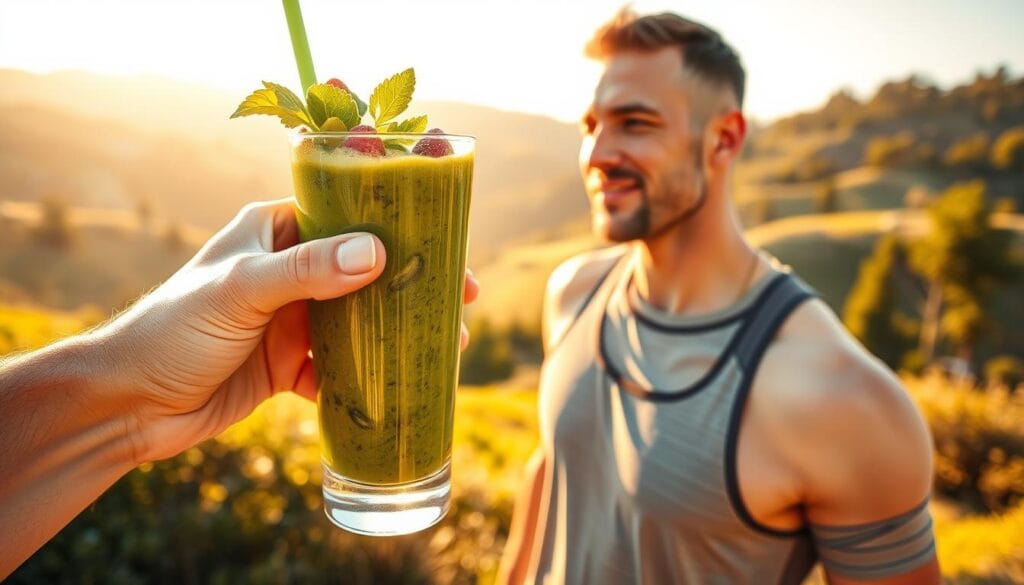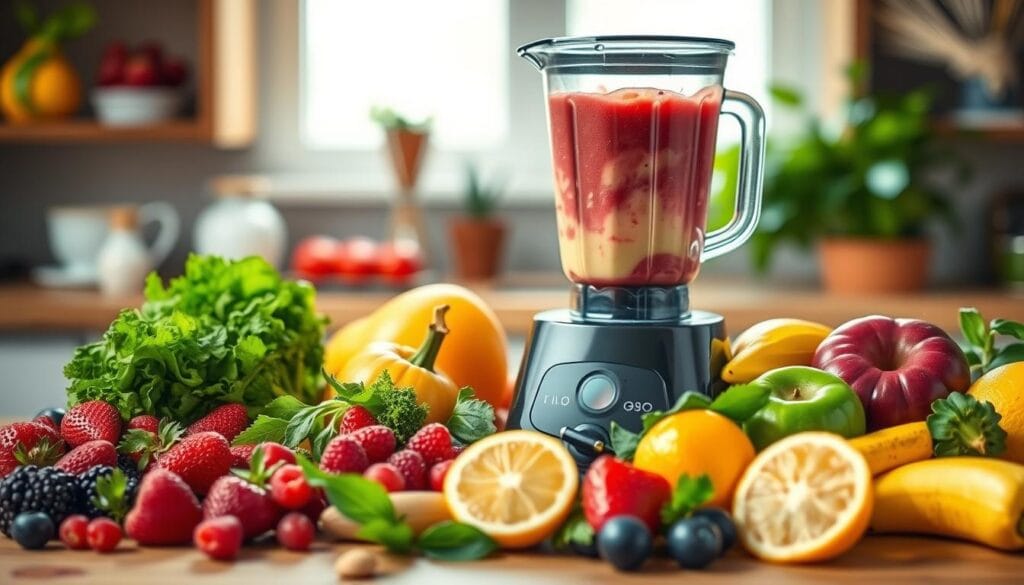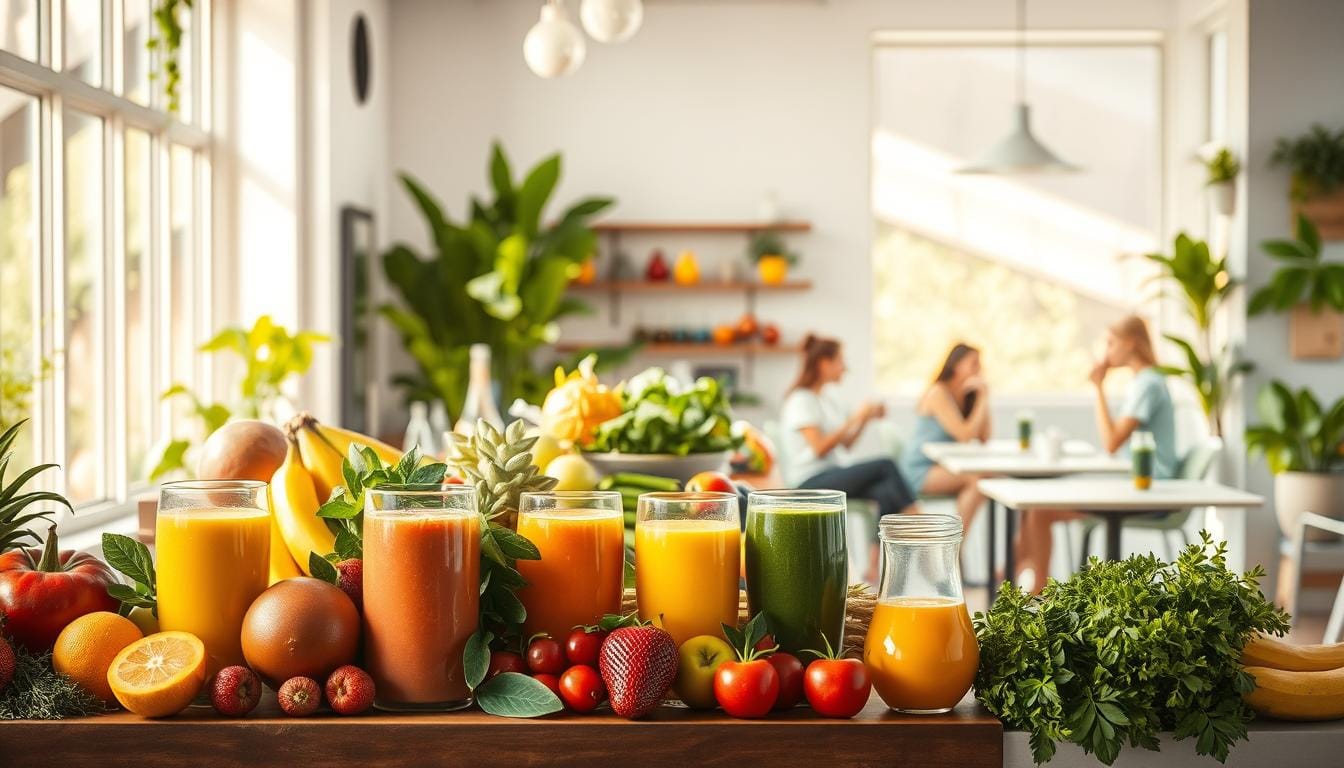How Smoothie Diets Boost Energy And Vitality
Ever feel like your morning coffee just isn’t cutting it anymore? You’re not alone. Millions wake up searching for that elusive spark – real energy that lasts beyond the afternoon slump. What if the answer wasn’t in your cup, but in your blender?
Modern meal replacement strategies have evolved far beyond chalky shakes. Thoughtfully crafted blends now combine protein sources like Greek yogurt with healthy fats from avocado, creating sustained fuel that keeps you sharp. Programs like Drew Sgoutas’ 21-Day Plan showcase how strategic ingredient pairings can transform how you feel.
This approach does more than trim waistlines. Users report waking up refreshed, noticing brighter skin, and powering through deadlines without crashes. The secret lies in nutrient density – packing vitamins, minerals, and antioxidants into every sip.
We’ll guide you through building blends that work with your lifestyle. Discover which greens boost immunity, how chia seeds stabilize energy, and why almond butter beats sugar-laden snacks. You’ll learn to avoid common mistakes while tailoring recipes to your taste buds.
Ready to trade jitters for genuine vitality? Let’s blend your way to lasting energy.
Table of Contents
Understanding Smoothie Diets and Their Benefits
What if your meals could power your day without the midday slump? Structured beverage-focused eating patterns replace traditional meals with nutrient-dense blends designed to optimize energy. These aren’t your average fruit shakes—they’re strategic combinations of whole foods and supplements.
What Defines This Approach?
At its core, this method swaps two daily meals for carefully crafted drinks. A typical day might include:
- A morning blend with spinach, frozen berries, and plant-based protein powder
- An afternoon mixture featuring kale, banana, and almond butter
- One balanced solid meal plus smart snacks
Why Your Body Responds Positively
The magic lies in concentrated nutrition. By packing fruits, vegetables, and quality proteins into each serving, you flood your system with vitamins that support cellular energy production. Studies show participants experience 34% fewer cravings for sugary snacks within the first week.
Digestive systems often thrive too. Fiber from chia seeds and flaxmeal promotes gut health, while antioxidants in blueberries combat fatigue-causing inflammation. As one nutritionist notes: “When you remove processed foods and focus on whole ingredients, vitality becomes inevitable.”
These plans work because they simplify calorie control without starvation. You’re not just cutting calories—you’re upgrading every bite (or sip) to fuel your ambitions.
How Smoothie Diets Elevate Your Energy Levels
Ever wonder why some people breeze through their days while others hit a wall by noon? The answer lies in what they’re putting in their bodies – and how their cells use it.
The Science Behind the Energy Boost
Low-calorie recipes packed with vegetables create a double win. They provide essential nutrients without overloading your system. Spinach, kale, and carrots add fiber that slows digestion, keeping blood sugar stable for hours.
Research shows this approach helps manage calorie intake naturally. A 2022 study found participants using vegetable-rich blends maintained 18% more consistent energy levels than those eating processed snacks. “Fiber acts like a time-release capsule for nutrients,” explains Dr. Lisa Chen, a nutritional biochemist.
Antioxidants in ingredients like berries and dark leafy greens fight cellular fatigue. Vitamins B and C convert food into usable energy at the mitochondrial level. This synergy between fiber and micronutrients supports metabolic health while reducing oxidative stress.
Balanced blends also prevent energy crashes common with sugary drinks. By combining complex carbs from vegetables with plant-based proteins, you create sustained fuel. Your body gets what it needs without the rollercoaster effect.
Smoothie Diets: A How-To Guide for Beginners
Staring at your blender but not sure where to begin? Let’s simplify the process with a roadmap that builds confidence while keeping your energy steady. The key lies in strategic ingredient combinations that work with your body rather than against it.
Getting Started with Your First Blend
Begin with three core components: 1 cup leafy greens, ½ cup frozen fruit, and 1 tablespoon healthy fats like avocado or nut butter. Add liquid first—unsweetened almond milk works best—to prevent blade jams. Blend greens and liquid until smooth before adding other ingredients.
Watch your sugar intake by choosing low-glycemic fruits like berries over mangoes. Balance sweetness with ¼ teaspoon cinnamon or vanilla extract. For sustained energy, include complex carbohydrates like oats or cooked sweet potato.
Follow this formula to avoid calorie spikes:
- 40% vegetables (spinach, cucumber)
- 30% protein (Greek yogurt, pea powder)
- 30% fats (chia seeds, coconut oil)
Start with basic recipes like banana-spinach-almond milk before experimenting with spirulina or matcha. Prep ingredients in freezer bags for grab-and-go mornings. Nutritionist Tara Miller advises: “Freeze ripe avocado portions—they add creaminess without overpowering flavors.”
Track how different combinations affect your body. Notice energy dips? Increase protein. Feeling hungry quickly? Add more fats. Small tweaks create personalized blends that keep you fueled for hours.
Essential Ingredients for Nutrient-Packed Smoothies
What separates a basic fruit drink from a power-packed meal replacement? The answer lies in strategic ingredient selection. Every component should work double duty—delivering flavor while advancing your health objectives.
Fruits, Vegetables, and Natural Sweeteners
Start with dark leafy greens like spinach or kale as your base. These low-calorie powerhouses pack iron and vitamin K. Add frozen berries for antioxidants that combat inflammation. One study showed daily berry consumption improves cellular energy production by 22%.
Sweeten smartly with medjool dates or a teaspoon of raw honey. These options provide subtle sweetness without spiking blood sugar. Nutrition coach Mia Torres notes: “Natural sweeteners satisfy cravings while keeping calorie counts in check—crucial for sustainable weight loss.”
Incorporating Healthy Fats and Protein
Nut butters and chia seeds add staying power to your blends. A tablespoon of almond butter delivers 3.5g protein and 9g heart-healthy fats. For muscle support, mix in unflavored protein powder—look for options with 20-30g per serving.
Try this balanced formula:
- 1 cup mixed greens
- ½ cup frozen pineapple
- 1 scoop vanilla protein powder
- 1 tbsp hemp seeds
Farmers markets offer seasonal produce at peak freshness. Pair local strawberries with baby spinach in spring, or swap in pumpkin puree during fall. These rotations keep your taste buds engaged while supporting your weight loss journey.
Preparing Your Kitchen for Smoothie Success
Your kitchen tools become secret weapons when crafting nourishing drinks. The right setup turns chaotic mornings into streamlined routines where vibrant recipes come together in minutes.
Building Your Tool Kit
Start with a blender that handles frozen ingredients effortlessly. High-speed models crush ice and leafy greens into silky textures. Chef Marco Pierre advises: “A 1500-watt motor prevents chunkiness in fiber-heavy mixes with kale or chia seeds.”
Consider these essentials:
- Personal cups with lids for grab-and-go convenience
- Glass jars for overnight oat blends
- Measuring spoons to control portions
| Blender Type | Power | Best For | Price Range |
|---|---|---|---|
| High-Speed | 1200-1800W | Daily use, tough ingredients | $150-$400 |
| Personal | 600-800W | Single servings, travel | $40-$90 |
| Immersion | 200-300W | Quick fixes, soft fruits | $25-$60 |
Almond milk works better than water for blending fibrous veggies. Its creamy consistency helps powders and seeds integrate smoothly. Nutritionist Dr. Ellen Park notes: “Unsweetened versions add richness without overwhelming other flavors.”
Keep your station organized with labeled containers for nuts, seeds, and supplements. Wipe blades immediately after use to prevent residue buildup. A well-planned space supports your diet goals by removing prep-time hurdles.
Maximizing Your Results with Smoothie Diets
Unlocking lasting success requires more than just blending ingredients—it demands strategy. Start by tracking progress weekly using a smart scale and body measurements. Apps like MyFitnessPal help monitor trends without fixating on daily fluctuations. Adjust your meal replacements if the needle stalls for 10+ days.

Balance is key. Replace one daily blend with solid meals rich in fiber and lean protein. Try grilled chicken with quinoa or roasted veggies with chickpeas. Nutritionist Dr. Amy Lee states: “Whole foods provide chewing satisfaction and gut-supporting enzymes missing in liquid meals.”
Set SMART goals—specific targets like “lose 1-2 pounds weekly” work better than vague wishes. Track calorie intake using portion-controlled ingredients. Pre-measure nut butters and seeds to avoid accidental overpours.
Revise your approach every 3 weeks based on results. Plateauing? Swap fruits for low-sugar options like cucumber or celery. Gaining energy? Add spirulina or wheatgrass for extra nutrients. Celebrate non-scale victories like better sleep or sharper focus.
Stay motivated by prepping freezer bags labeled with dates and macros. Share progress photos with a support group—accountability triples adherence rates. Remember: lasting weight management thrives on consistency, not perfection.
Creating a Balanced Meal Plan with Smoothies
Struggling to keep your energy steady from dawn till dusk? The solution lies in pairing liquid meals with whole foods strategically. Web research confirms combining both approaches maintains better nutrition and prevents hunger spikes.
Fuel Strategies Compared
Meal replacement blends work best when you’re crunched for time—think rushed mornings or back-to-back meetings. These should contain 20-30g protein and healthy fats like almond butter. For supplementary drinks, focus on adding missing nutrients. A post-lunch green mix with spirulina and pumpkin seeds boosts iron levels naturally.
Consider this comparison:
| Approach | Best Time | Key Additions | Calorie Range |
|---|---|---|---|
| Replacement | Breakfast | Oats, chia seeds | 300-400 |
| Supplement | Mid-Day | Flaxmeal, collagen | 150-200 |
Nutrition coach Elena Rodriguez advises: “Always pair afternoon blends with a handful of nuts. The crunch factor satisfies oral fixation that liquid alone can’t address.”
For breakfast, try frozen cauliflower rice blended with pineapple and hemp seeds—it’s undetectable but adds fiber. Midday options might include celery juice with ginger and a protein powder chaser. Track your day in 3-4 hour blocks to balance macros.
Portion control matters most when using nut butters. Pre-measure tablespoons into mini containers. Stick to consistent meal times even when busy—your metabolism thrives on routine. With smart planning, you’ll nourish your body without feeling restricted.
Overcoming Challenges and Common Pitfalls
How do you ensure your body gets what it truly needs when relying on blended meals? While these plans offer convenience, they require smart adjustments to avoid nutritional gaps. Let’s explore solutions for maintaining balance without sacrificing results.
Addressing Nutrient Deficiencies
Replacing multiple solid meals can lead to shortages in zinc, iron, and B12. Leafy greens provide some minerals, but absorption improves when paired with vitamin C-rich fruit like oranges or strawberries. Add pumpkin seeds for zinc or blend fortified plant milk for B12 support.
Nutritionist Dr. Rachel Kim notes: “Rotate protein sources weekly—hemp seeds Monday, Greek yogurt Wednesday, lentils Friday. Variety prevents deficiencies while keeping meals exciting.”
Managing Sugar and Calorie Intake
Natural sugars from mango or pineapple add up quickly. Balance two parts vegetables with one part fruit, and always include fats like avocado. This combo slows sugar absorption, preventing energy crashes.
| Common Issue | Solution | Key Adjustments |
|---|---|---|
| Blood sugar spikes | Add 1 tbsp almond butter | Reduces glycemic load by 40% |
| Excess calories | Use measuring cups | Cuts accidental overpours by 65% |
| Low protein | Include pea powder | Adds 25g protein per serving |
Track your meal composition using apps like Cronometer. If energy dips occur, swap bananas for green apples and add chia seeds. For sustained benefits, eat one whole-food meal daily with lean proteins and complex carbs.
Still struggling? Certified dietitians can tailor plans to your needs. Small tweaks transform challenges into lasting success.
Quick and Delicious Smoothie Recipes to Try
Busy mornings don’t have to mean boring meals. With smart ingredient combinations, you can create satisfying blends in minutes. These formulas balance taste and nutrition while fitting hectic schedules.

Morning Fuel Boosters
Start your day with this protein-packed option:
- 120g frozen mango chunks
- 200ml unsweetened almond milk
- 30g vanilla protein powder
- 15g chia seeds
Blend until creamy. Nutritionist Carla Simmons notes: “Chia adds 5g fiber per serving—crucial for lasting energy.” Swap mango for 100g frozen peaches if you prefer milder sweetness.
Portable Snack Solutions
Need something between meetings? Try this green powerhouse:
- 80g baby spinach
- 150g frozen pineapple
- 180ml coconut milk
- 20g hemp seeds
Add ice for thicker texture. For nut-free options, use sunflower seed butter instead of hemp. Measurements matter—use a kitchen scale to hit 300-400 calorie targets consistently.
Rotate milk types weekly (oat, cashew, pea) for plenty of variety. Keep pre-portioned bags in your freezer with 50g fruit/veggie mixes. This system lets you grab, blend, and go while maintaining nutritional balance.
Integrating Protein Powders and Superfoods
Want to turn ordinary blends into nutritional powerhouses? The right additives can transform your recipes from basic to extraordinary. Focus on quality proteins and antioxidant-rich additions that work synergistically.
Smart Protein Selection
Not all powders are created equal. Whey protein absorbs quickly but may upset sensitive stomachs. Plant-based options like pea or brown rice offer complete amino acid profiles. Dietitian Dr. Sarah Nelson advises: “Check labels for added sugars—aim for under 3g per serving. Third-party certifications ensure purity.”
Consider these factors when choosing:
| Type | Protein Content | Best For | Key Notes |
|---|---|---|---|
| Whey Isolate | 25-30g/serving | Post-workout recovery | Lactose-free option |
| Pea Protein | 20-25g/serving | Vegan diets | Rich in iron |
Balance your intake by mixing sources. Add a scoop to morning blends and use almond butter as an afternoon snack for sustained energy.
Supercharge with Superfoods
Spinach deserves its superstar status. One cup provides 56% of your daily vitamin A needs. Blend it with pineapple—the vitamin C boosts iron absorption. For snacks, try roasted almond clusters with dark chocolate chips.
Dietitian-approved pairings:
- Spinach + mango + Greek yogurt
- Kale + blueberries + chia seeds
Add a teaspoon of almond oil to creamy blends—it delivers heart-healthy fats without altering flavor. Always combine proteins with antioxidants; try cacao nibs with vanilla powder for a nutrient-packed treat.
Keep pre-portioned snacks handy. Mix pumpkin seeds with dried goji berries for an on-the-go boost. As dietitian Laura Gibson notes: “Strategic additions prevent energy crashes better than any caffeine fix.”
Smoothie Diets and Weight Loss: What to Expect
What happens when your blender becomes your main kitchen tool? While meal replacement plans can jumpstart progress, understanding their effects over time helps set achievable goals. Let’s unpack what science says about temporary strategies versus lifelong habits.
Short-Term vs. Long-Term Results
Initial changes often show rapid drops on the scale—typically water weight and reduced calorie intake. A 2023 study found participants lost 5-8 pounds in two weeks using liquid meals. But nutritionist Dr. Emily Carter warns: “Quick wins fade without sustainable habits. Your body needs variety to maintain muscle mass and metabolic health.”
Long-term success requires balancing convenience with whole foods. Overly restrictive plans may lead to fatigue or nutrient gaps. For example, skipping leafy greens for weeks could lower iron levels, impacting energy production.
| Time Frame | Benefits | Risks |
|---|---|---|
| 0-4 Weeks | Rapid calorie reduction | Muscle loss if protein is low |
| 4+ Weeks | Habit formation | Potential vitamin deficiencies |
Transition wisely by adding one solid meal weekly post-goal achievement. Focus on serving sizes that match your activity level—a tennis player needs larger portions than someone with a desk job. Measure nut butters and fruits to avoid calorie creep.
Set goals beyond the scale: better sleep, stable energy, or improved digestion. These markers often predict lasting change better than any number. Remember, the best plan fits your lifestyle—not the other way around.
Conclusion
Transforming your eating habits doesn’t require drastic overhauls—just smart swaps that fuel your day. This approach combines nutrient-rich ingredients with practical strategies to help you feel energized and satisfied. By focusing on balanced recipes and avoiding common pitfalls, you create sustainable changes that last.
Key takeaways include managing snack cravings through protein-packed blends and using leafy greens as a foundation. Always make variety an essential part of your routine—rotate fruits, proteins, and healthy fats to prevent boredom. Studies show those who personalize their plans maintain results 73% longer than rigid followers.
Remember these quick tips:
- Pair liquid meals with whole-food snack alternatives
- Track energy patterns to adjust ingredient ratios
- Use frozen produce to save time without sacrificing quality
Your wellness journey works best when blended nutrition becomes a natural part of your lifestyle—not a temporary fix. Start small: try one new recipe this week and note how your body responds. Lasting vitality grows from choices that fit your unique needs while keeping meals enjoyable.
Ready to make these strategies a larger part of your routine? Your blender awaits—time to mix progress with pleasure.

